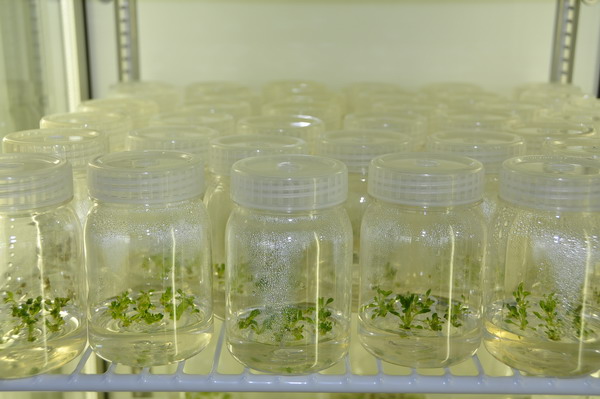PLOS ONE:陈晓亚课题组挖掘丹参酮生物合成相关基因及转录调控
日前,中国科学院上海辰山植物科学研究中心药用植物与次生代谢研究组(陈晓亚研究员课题组)杨蕾博士等在药用植物丹参转录组分析上取得新进展。相关文章发表于2013年11月19日的《PLOS ONE》杂志上。
丹参代谢调控

丹参组织培养
丹参(Salvia miltiorrhiza)为唇形科(LABIatae)鼠尾草属常用中药,以根和根茎入药,药理学表明丹参中丹参酮类化合物对于治疗心脑血管疾病具有显著疗效。丹参酮类物质特异性地积累在丹参的根中,所以该研究通过对比丹参根和叶不同组织中转录表达的差异基因来挖掘丹参酮生物合成相关的基因及转录调控因子,为进一步研究丹参酮类的生物合成及调控奠定了基础。
该研究成果获得国家自然科学基金及上海市绿化和市容管理局科学技术项目等多项资助。
原文摘要:
Transcriptome Analysis of Medicinal Plant Salvia miltiorrhiza and Identification of Genes Related to Tanshinone Biosynthesis
Lei Yang, Guohui Ding, Haiyan Lin, Haining Cheng, Yu Kong, Yukun Wei, Xin Fang, Renyi Liu, Lingiian Wang, Xiaoya Chen, Changqing Yang
Salvia miltiorrhiza Bunge, a perennial plant of Lamiaceae, accumulates abietane-type diterpenoids of tanshinones in root, which have been used as traditional Chinese medicine to treat neuroasthenic insomnia and cardiovascular diseases. However, to date the biosynthetic pathway of tanshinones is only partially elucidated and the mechanism for their root-specific accumulation remains unknown. To identify enzymes and transcriptional regulators involved in the biosynthesis of tanshinones, we conducted transcriptome profiling of S. miltiorrhiza root and leaf tissues using the 454 GS-FLX pyrosequencing platform, which generated 550,546 and 525,292 reads, respectively. RNA sequencing reads were assembled and clustered into 64,139 unigenes (29,883 isotigs and 34,256 singletons). NCBI non-redundant protein databases (NR) and Swiss-Prot database searches anchored 32,096 unigenes (50%) with functional annotations based on sequence similarities. Further assignments with Gene Ontology (GO) terms and KEGG biochemical pathways identified 168 unigenes referring to the terpenoid backbone biosynthesis (including 144 MEP and MVA pathway genes and 24 terpene synthases). Comparative analysis of the transcriptomes identified 2,863 unigenes that were highly expressed in roots, including those encoding enzymes of early steps of tanshinone biosynthetic pathway, such as copalyl diphosphate synthase (SmCPS), kaurene synthase-like (SmKSL) and CYP76AH1. Other differentially expressed unigenes predicted to be related to tanshinone biosynthesis fall into cytochrome P450 monooxygenases, dehydrogenases and reductases, as well as regulatory factors. In addition, 21 P450 genes were selectively confirmed by Real-Time PCR. Thus we have generated a large unigene dataset which provides a valuable resource for further investigation of the radix development and biosynthesis of tanshinones.

